Making Goat Cheese
Welcome back to the final chapter of our foray into the world of goats and their cheese. Oh, I've had fun with this one. Here is the Fort Knox of goat cheese. Ye gods.
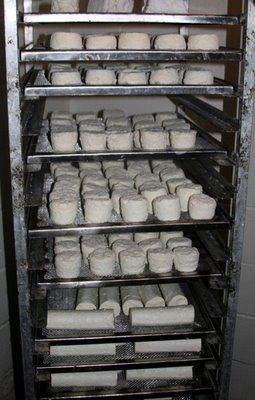
In the third chamber of the dairy, behind the cooling room, is the cheese making room. Each room smells different, and this one has the most intriguing smell of all. Here, the milk goes directly from the teats into a stainless steel pasteurizer,
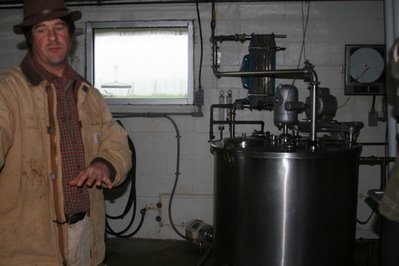 which heats it, using kilocalories from the two biggest water heaters I've ever seen. They were like 7' high. Then, it goes into a huge cooling tank, where it's stirred with a big paddle until it's cool enough to add cultures. From there, it goes into two big open vats, where cheese cultures (live bacteria) and rennet (an enzyme from calf stomachs, that curdles milk) are added. Brad told me that milkweed sap contains rennet, too, but he uses calf rennet. Brad learned to make goat cheese in a lengthy apprenticeship in France, right after college. He was Bill's roommate! and what fun they had. Brad lives life in the moment, and his letters read like the musings of an unself-conscious beat poet. I don't know anyone with a fresher take on life.
which heats it, using kilocalories from the two biggest water heaters I've ever seen. They were like 7' high. Then, it goes into a huge cooling tank, where it's stirred with a big paddle until it's cool enough to add cultures. From there, it goes into two big open vats, where cheese cultures (live bacteria) and rennet (an enzyme from calf stomachs, that curdles milk) are added. Brad told me that milkweed sap contains rennet, too, but he uses calf rennet. Brad learned to make goat cheese in a lengthy apprenticeship in France, right after college. He was Bill's roommate! and what fun they had. Brad lives life in the moment, and his letters read like the musings of an unself-conscious beat poet. I don't know anyone with a fresher take on life.The yellow liquid floating atop the curd is whey.
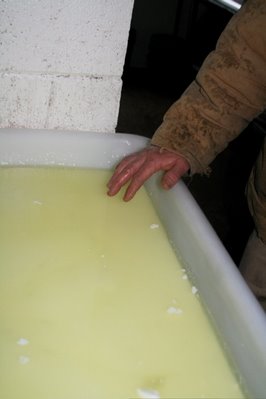 These two vats hold the milk from seven milkings of Brad's goats.
These two vats hold the milk from seven milkings of Brad's goats. 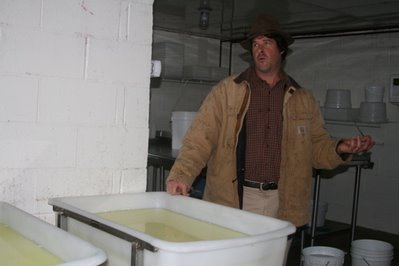 At certain times of year, Brad buys milk from other goat farms, and brings it in to augment his. His goats are drying up now, and he's about to take a break from milking and cheesemaking so he and the family can go visit at Christmas time.
At certain times of year, Brad buys milk from other goat farms, and brings it in to augment his. His goats are drying up now, and he's about to take a break from milking and cheesemaking so he and the family can go visit at Christmas time.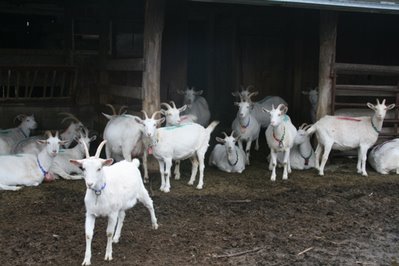
The goats are all color-coded with spray paint. Orange means a goat is being milked once a day; green means twice. Blue means a goat is dry. When correlated with the numbered tags around their necks, each goat can be identified and given a milking regime specific to its hormonal stage. Goats freshen, or begin lactating a whole lot, when kids are born, but they can also be milked about four months into their pregnancy. A goat needs to keep producing kids in order to keep lactating, just like a dairy cow. That's where those billies come in. Back to the cheese room:
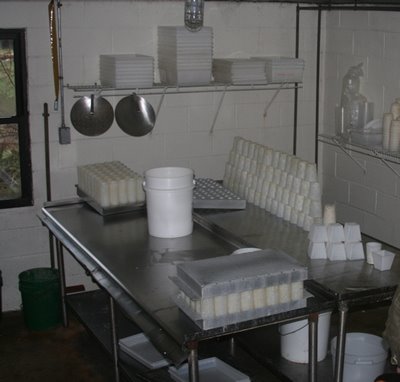
When the curd sitting in those vats is the right consistency, it's put into forms made of plastic. These forms, richly perforated with holes, need to be washed by hand every time they're used--a time-consuming prospect. There are cones and tubes and pyramids, as well as little flat tubs for the fresh goat cheese. Fresh cheese from Pipe Dreams Fromage is like whipped cream cheese from heaven. There is nothing like it. It's almost foamy. Put it on a good cracker maybe with a cherry tomato fresh from the garden, a little basil leaf...oh, heaven can wait.
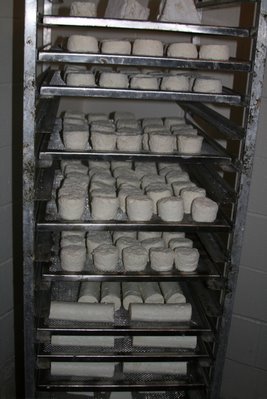 All the different types of cheese start with the same curd; what differs is the time they're allowed to age, and in some cases the type of cheese culture added to the curd.
All the different types of cheese start with the same curd; what differs is the time they're allowed to age, and in some cases the type of cheese culture added to the curd.When the cheese starts to form a skin, it's put in the ageing room, which is a little dim chamber off the cheesemaking room. It's cool in there, just right, moist...the cheese ages quietly on baker's racks, making a fabulous, Brie-like skin. Molds help with that.
Brad rolls some of the cheeses in ash.
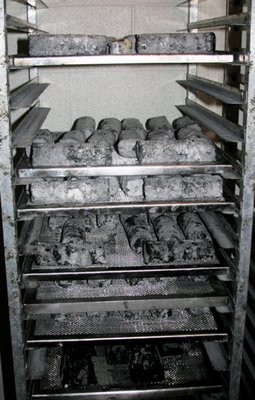 My favorite is the "Ashy Log," 11 oz. of pure heaven. It's salty and tangy and when it's dried out a bit, it's about the texture of a good hard Parmesan. Fresh, like the one I'm enjoying now, it's like a cross between cream cheese and hard cheddar in consistency. The skin is rumpled and ashy. White mold grows over the black ash, and it's all delicious. I allow myself one visit to the Ashy Log in the door of my fridge every afternoon. I stand all alone at the kitchen counter, eating goat cheese on whole grain flaxseed crackers, and making little umm umm umm noises. Nobody else in my house likes it. That much more for me.
My favorite is the "Ashy Log," 11 oz. of pure heaven. It's salty and tangy and when it's dried out a bit, it's about the texture of a good hard Parmesan. Fresh, like the one I'm enjoying now, it's like a cross between cream cheese and hard cheddar in consistency. The skin is rumpled and ashy. White mold grows over the black ash, and it's all delicious. I allow myself one visit to the Ashy Log in the door of my fridge every afternoon. I stand all alone at the kitchen counter, eating goat cheese on whole grain flaxseed crackers, and making little umm umm umm noises. Nobody else in my house likes it. That much more for me.One of the reasons some people don't like goat cheese is its smell. That smell comes from caproic acid, the carboxylic acid derived from hexane with the general formula C5H11COOH (although I also found it as C6H12COOH). It is a colorless oily liquid with an odor reminiscent of goats or other barnyard animals. This fatty acid is found naturally in various animal fats and oils, and is one of the chemicals that gives the decomposing fleshy seed coat of the ginkgo its characteristic unpleasant odor. Well. I've smelled a ginkgo tree in fall, when the fruits are lying underfoot, and I can tell you that goat cheese smells nothing like THAT.
So yeah, our fridge smells weird, but I'll take care of that as soon as I finish the second Ashy Log. It's worth it, at least to me. Bill tells me that his desire to get another beer is significantly compromised by it. Well, isn't that a good thing?
Goat's milk is rich in fats containing the 6-, 8-, and 10-carbon acids (caproic, caprylic, and capric acids, respectively; these names are all derived from the Latin root caper, meaning goat). These fat globules are smaller than those in cow's milk, one of the things which makes goat milk so much easier to digest. Brad told me that the composition of goat milk varies according to the time of year, and this time of year it's higher in calcium. All of this affects how it ages, and it's harder to age cheese in the winter. So the cheese is softer now than it was earlier in the year.
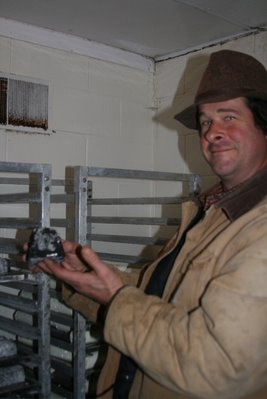 Brad sells almost all his goat cheese in the Washington/Baltimore area, where area chefs quickly snap it up. I'd love to be able to tell you that you can order it online, but that's not in the cards just yet. My siblings have all reported back that they received their shipment, and are enjoying it. Zickefooses should be eating goat cheese***
Brad sells almost all his goat cheese in the Washington/Baltimore area, where area chefs quickly snap it up. I'd love to be able to tell you that you can order it online, but that's not in the cards just yet. My siblings have all reported back that they received their shipment, and are enjoying it. Zickefooses should be eating goat cheese***Speaking of snapping up goat cheese, here's Oona and her mom Margaret, sampling both the Ashy Log aged cheese and the fresh curd.
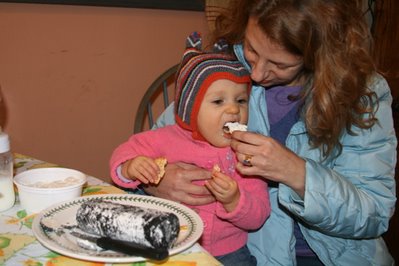
There's not much Oona won't eat, it's true, but she moved in for more fresh cheese the moment she got a load of it. It was clear she dug it hugely. Sweets for the ultra-sweet. Dig those ears on her bonnet.

Here's to Brad and Jenny and Pipe Dreams Farm, to ancient crafts studied in France and brought over intact to Pennsylvania, to fresh curd and the Ashy Log, to sustainable farming, and to goats everywhere.
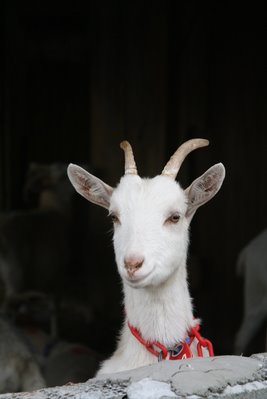
***Did you say your name was Zickefoose? You know that means "goat's foot," auf Deutsch, don't you?
Labels: ageing goat cheese, caproic acid, cheese forms, goat cheese, milk composition, Pipe Dreams Farm






<< Home